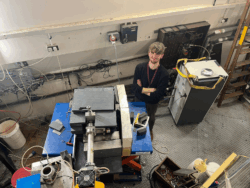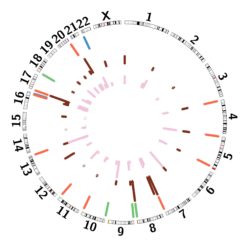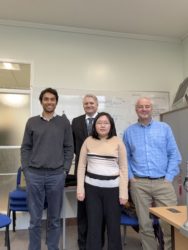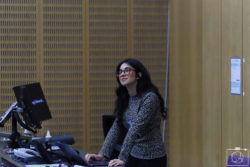In this case study we hear from Louis Butt, a doctoral researcher from Metallurgy and Materials, who has been using BlueBEAR to research accelerator-based neutron sources. I am a PhD student researching accelerator-based neutron sources in the School of Metallurgy and Materials. My work involves taking measurements with our source at the University’s MC40 Cyclotron … Continue reading “Modelling accelerator-based neutron sources using the BlueBEAR cluster”
Category: Case study
The value of version control
The Research Software Group’s mission is rooted in the observation that most current research requires software, often written by researchers themselves, and that the application of a few core software engineering principles leads to more effective research. This is neatly captured by the Software Sustainability Institute‘s tag line: “better software, better research”. A core technology … Continue reading “The value of version control”
Investigating the Alternative Lengthening of Telomeres (ALT)
In this case study we hear from Ronan and Anubrata, both research staff in Cancer and Genomic Sciences, who have been using BlueBEAR to find therapeutic targets and biomarkers for the diagnosis of ALT-reliant cancers such as high-grade glioma. Our lab is investigating the Alternative Lengthening of Telomeres (ALT) process; a molecular mechanism used by … Continue reading “Investigating the Alternative Lengthening of Telomeres (ALT)”
Molecular simulations of small peptides as a means to interpreting mass spectra
In this case study we hear from Edwin, a PhD student in Biochemistry,who has been using BlueBEAR to evaluate the effectiveness of different Molecular Dynamics (MD) simulation protocols at assigning structural information to Ion Mobility data Ion Mobility Spectrometry (IMS), Traveling Wave Ion Mobility Spectrometry (TWIMS) and High-Field Asymmetric Wave Ion Mobility Spectrometry (FAIMS) are … Continue reading “Molecular simulations of small peptides as a means to interpreting mass spectra”
Energy Data Landscape – Challenges and Opportunities
Edward Barbour and Grant Wilson, Associate Professors in Chemical Engineering, explored detailed domestic heat pump demand data and became interested in their operational costs under different energy tariffs. They quickly discovered that tariff data was difficult to obtain and compare across different suppliers. With help from Mingxue (Jean) Du, a Research Software Engineer, they identified … Continue reading “Energy Data Landscape – Challenges and Opportunities”
SMLM Data Exploration with Nano-org and BlueBEAR
This case study highlights the ongoing collaboration between the Research Software Group, Professor Dylan Owen, and Dr Sandeep Shirgill in the development of Nano-org. Nano-org has recently been published in Nature Communications. Nano-org uses ultra-precise coordinate data to represent the nanoscale distributions of individual proteins within cells. The unique functionality provided by Nano-org supports a … Continue reading “SMLM Data Exploration with Nano-org and BlueBEAR”
Bayesian Modelling of Rising Decision Thresholds in DDMs using BlueBEAR
In this case study we hear from Sophie Wetz, a Masters student in Psychology, who has been using BlueBEAR to investigate whether a dynamic, rising boundary improved the fit of the full Drift Diffusion Model (DDM) to Random Dot Kinematogram (RDK) task data. I’m a Master’s student on the Computational Neuroscience stream in the School … Continue reading “Bayesian Modelling of Rising Decision Thresholds in DDMs using BlueBEAR”
Atomic Simulation to Build Better Batteries
In this case study we hear from Oskar Soulas, a PhD student in Chemistry, who has been using BlueBEAR to investigate lithium–sulphur–nitrogen solid electrolytes for next-generation battery technologies. I am a second year PhD student in the Scanlon Materials Theory Group (SMTG) based at the University of Birmingham. The group uses powerful computational tools to understand … Continue reading “Atomic Simulation to Build Better Batteries”
Bio-inspired FSI and HPC-driven aerodynamic optimisation
In this case study we hear from Hibah Saddal, a PhD student in Aerospace Engineering, who is using BlueBEAR to optimise aerodynamic performance. At the 14th BEAR Conference 2025, I had the opportunity to present my research carried out with my PhD advisor, Dr Chandan Bose, on bio-inspired fluid-structure interaction (FSI) problems, where we leveraged … Continue reading “Bio-inspired FSI and HPC-driven aerodynamic optimisation”
High-Resolution Soil Hydrology Analysis Enabled by BlueBEAR
In this case study, we hear from Guilin Luo, a PhD student in the School of Geography, who has been harnessing BEAR’s advanced computing resources to investigate how temperate forest soils respond to climatic change. By integrating high-resolution environmental monitoring data from the Birmingham Institute of Forest Research (BIFoR) site, and using workflows in R … Continue reading “High-Resolution Soil Hydrology Analysis Enabled by BlueBEAR”










